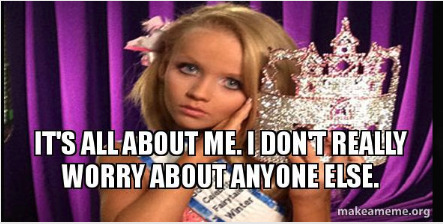Sales Stories 101: Crafting an effective narrative
When was the last time you told a good story? What about a good sales story? A compelling narrative can be the difference between a pitch that converts prospects into clients and one that falls flat.
Let’s gather around our metaphorical campfire for some real talk. You may need to work on your sales story if:
- When employees describe the company mission, no one’s on the same page
- You rely on marketing tools (brochures, PowerPoints) as a crutch in your sales approach
- Your sales pitches tend to be an idealistic stretch and aren’t grounded in reality
- You’re having trouble closing deals and aren’t meeting sales goals
Sound familiar? Let’s explore what makes an effective sales story and how to beef yours up.
L’eggo my ego
Let’s face it: we’ve all heard those sales pitches that scream, “ME. ME. ME.”
The salesperson is droning on about his company’s services and remarkable ROI, but all I hear is:
It’s tempting to start a sales presentation by diving into your products, services, clients and all the data that proves your company is amazing.
Don’t.
To be fair, it’s an approach that worked for years, but there’s no doubt the “times (and today’s consumer) are a-changin’.”
There’s a reason we don’t see ads like this anymore (despite the obvious one):
Instead we’re seeing more ads like this (arguably one of my favorite commercials in recent history):
I know what you may be thinking: “A TV ad isn’t the same as an in-person sales pitch, Steven. You can’t compare apples to oranges.” But my point applies to both scenarios: storytelling that appeals to the buyer’s perspective, connects with them emotionally and is focused on their needs is more effective than talking about yourself.
I know we sometimes like to clutch them close to our chests, but there comes a time when we need to let go of our egos. (I didn’t say anything about Eggos.)
[Source: bonappetit.com]Your sales story
Nowadays, people aren’t interested in what your company can do, they’re interested in what your company can do for them.
In other words, your approach should not be “look how great my company is,” but instead, “here’s how our client’s life got better thanks to our help.”
First and foremost consider the buyer’s perspective. Think, talk and act like the buyer. Become the buyer.
Is storytelling really that important? Yes. Not only are stories more interesting, science proves they’re persuasive.
But before crafting the most beautiful narrative since James Cameron’s Titanic, you must establish your identity and create a lean foundation to build on.
[Source: tenor.co]
In his book, New Sales. Simplified., Mike Weinberg offers an outline for constructing what he calls a “power statement” (because, let’s face it, no one pitches in elevators anymore). It’s an easy way to narrow your business focus and ultimately help develop your sales story.
The power statement consists of:
- Headline
- Transitional phrase
- Client issues / pains removed / problems solved / results achieved
- Offerings
- Differentiators
Let’s break it down.
Headline
This is a one- to two-sentence introduction that places your business into a category and provides some context to your story. Keep it short and sweet.
Transitional phrase
Grab your contact’s attention with this brief phrase. Don’t start with “we” or “our company,” though. Instead, lead in with “Tech companies turn to us when…” or “Senior marketing executives look to us for…” Use this sentence to set up the type of business you’re pursuing and to transition into…
Client issues / pains removed / problems solved / results achieved
In this section, list three to seven client issues you address. Use a conversational, bulleted format with strong, emotionally charged words.
Offerings
Here is where you mention what you actually sell. Offerings are the least compelling component of the story, so keep it brief, simple and don’t embellish or oversell.
Differentiators
This is your opportunity to list a few reasons why you’re the best choice to solve those issues above. Set up the list with a dynamic sentence like, “Clients experience tremendous success and rave about our work because our approach is very different from what you normally find…”
So how does all of this play out? Here’s an example of a power statement for a security company that Weinberg helped craft:
HEADLINE
Allsafe Security is the premier security services provider in Canada. We work with building owners, property managers and individual corporations to deliver true integrated security.
TRANSITIONAL PHRASE AND CLIENT ISSUES ADDRESSED
Building owners look to Allsafe when:
— Seeking a competitive advantage by offering the finest security available to tenants and guests.
— Frustrated that their current system is not doing what was promised when it was “sold” to them.
— Facing excessive liability exposure and growing life/safety fears.
— Continually embarrassed by the image projected by their security personnel.
— They’ve had it with guards who are poorly trained, unreliable and constantly turning over.
— They’re searching for a truly integrated solution combining manpower, system monitoring and CCTV.
— There is no peace of mind regarding a potential emergency; the current provider lacks the appropriate resources, coverage and experience to handle a crisis.OFFERINGS
We provide true integrated security. Allsafe services include first-class manpower, access systems, monitoring, mobile response and closed-circuit television.
DIFFERENTIATORS
Allsafe continues to dominate the security market because we are very different from the other available alternatives:
— We are a true one-stop shop that provides real integrated solutions.
— We offer in-house financing and leasing options to help clients manage capital expenditures and cash flow.
— We are “vendor agnostic,” allowing us to provide the best-fit products for your particular application.
— No one handles crisis situations better or responds faster. It is our specialty.
— We have, without question, the most professional, polished, responsible and courteous officers in the business; clients tell us that our officers are like their own key employees.
— Our clients don’t leave us. And the very few that did came back.
Building out a power statement can help focus your company’s mission and hone your sales story. Ultimately, the best sales stories are captivating, relatable, differentiating and client-focused. As you develop your narrative, use these as guideposts to keep your sales story on track.
[Source: alphagraphics.com]
Building a client-focused narrative
Once you’ve created this internal blueprint, it’s time to think about selling your story to prospects.
Andy Raskin lays out a solid infrastructure to building a narrative that will knock your sales presentation out of the park:
- Name a major shift in the world that affects your prospect
- Demonstrate how that shift will create winners and losers
- Offer a glimpse at how life can be better for the winners
- Introduce your features as “gifts” for overcoming the obstacles to becoming a winner
- Present evidence that you can lead them to success (i.e. how you’ve helped others)
The common theme? Positioning your story as client-centric. Rather than immediately opening with a prospect’s problems and how to solve them — which can sometimes make them defensive — start with an external change that affects everyone. Those who adapt to the change will come out on top, and that’s where you can help.
Moving the sales conversation from “us” to “you” is a foundational shift that can catapult your sales efforts to a new level. Tap into your inner storyteller and give it a shot. You may surprise yourself (and your prospects) with your revamped sales story.
Got questions? Success stories? Leave a comment below, hit me up on Twitter or email me at steven@rep-ink.com.














[…] A compelling narrative can be the difference between a pitch that converts prospects into clients and one that falls flat. That’s why sales stories are so important. (If you’re wondering what a sales story is, now would be a good time to catch up on my previous blog post about them.) […]